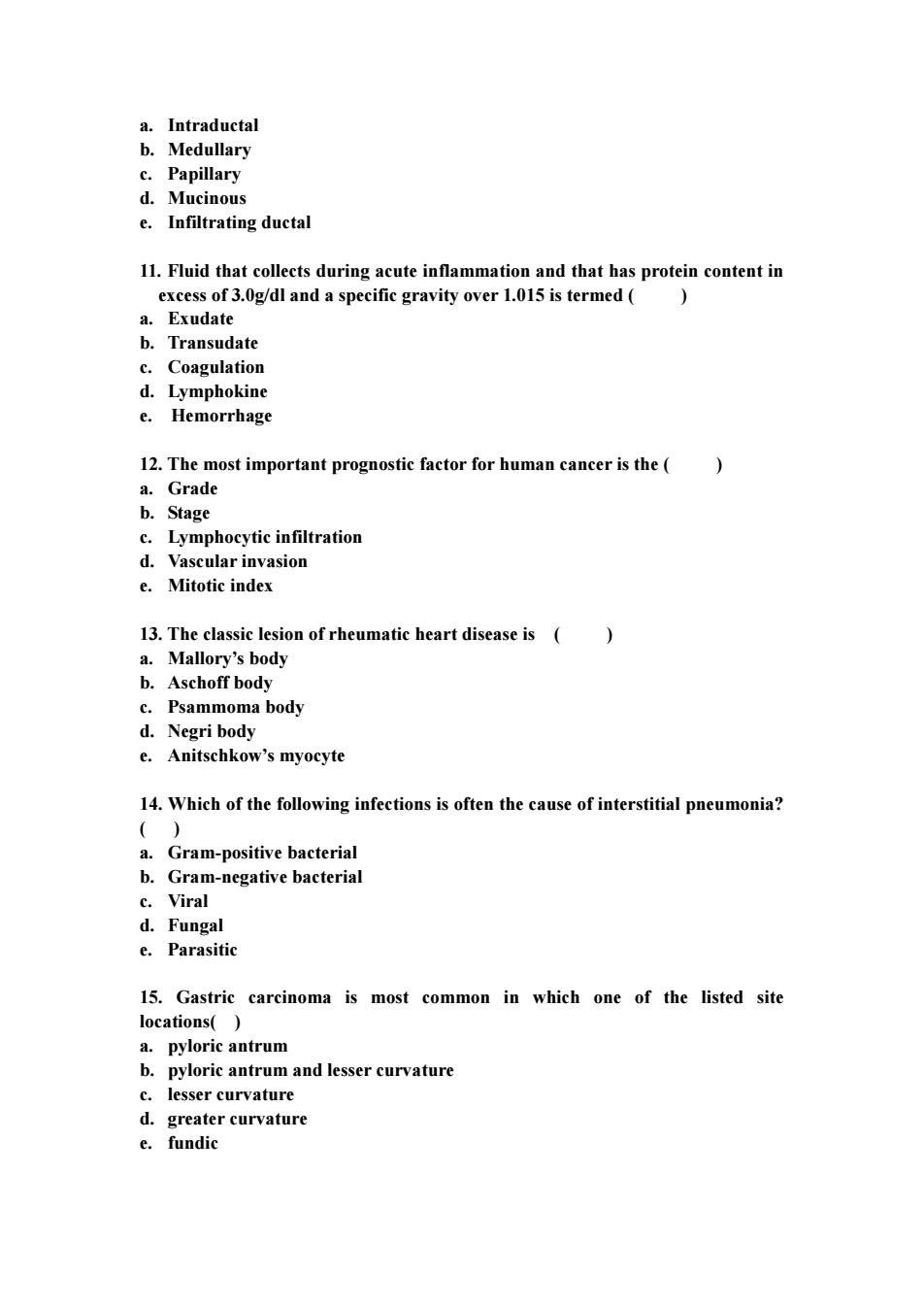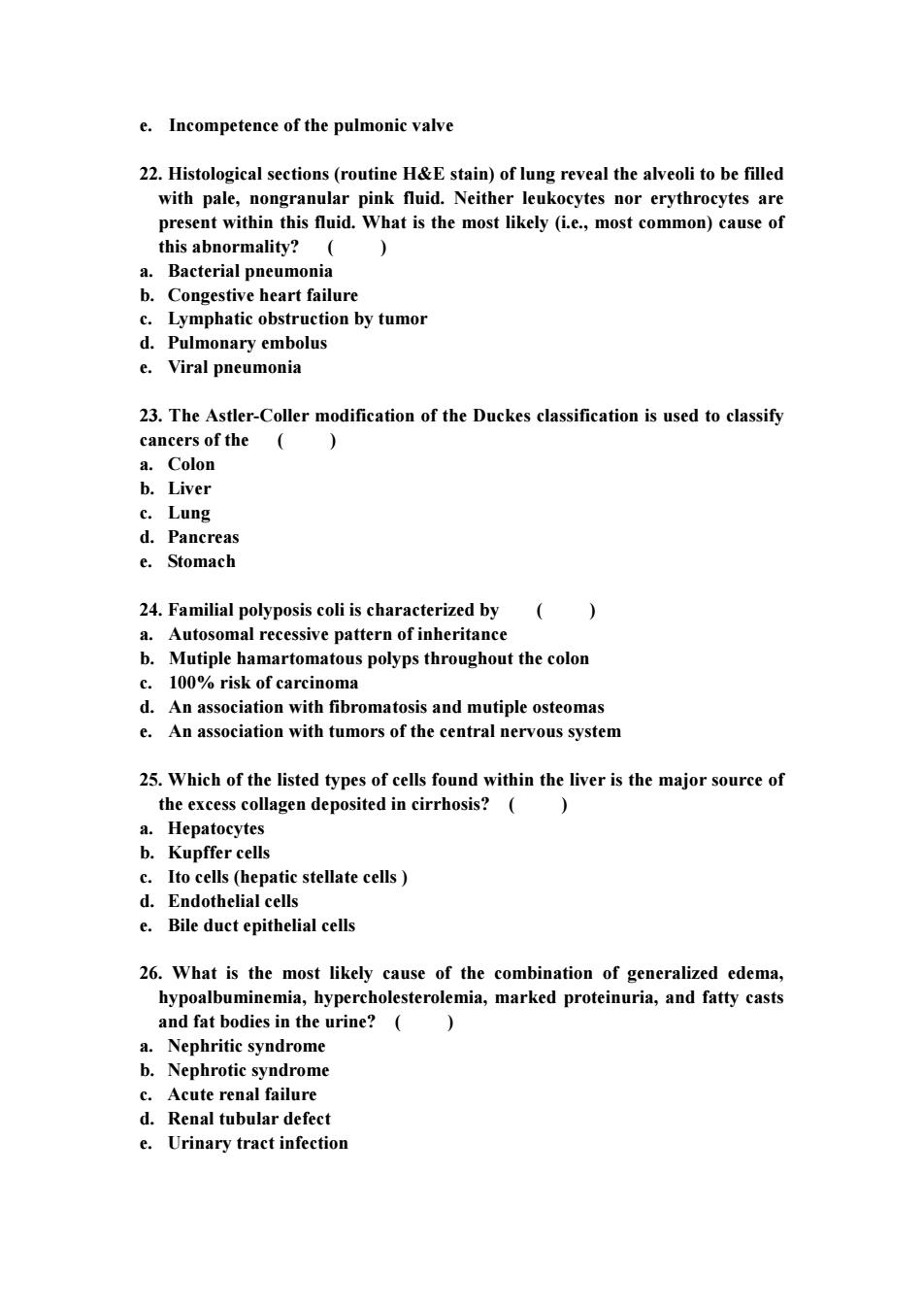
Tongji Univesity School of Medicine 2014-2015 Academic Year,the 2s semester Final Examination of (Test paper A) Name ID IAtypel question (One point Fach question below contains five suggested answers.Choose the one best response to each question 1.During acute inflammation,histamine-induced increased vascular permeability causes the formation of exudates (inflammatory edema).Which e of the listed cell types is the most likely source of the hista ine? Fibroblasts c.Lymphocytes d.Mast cells e.Neutrophils 2.Histologic sections of lung tissue from a 68-year-old female with congestive heart failure and progressive breathing problems reveal numerous hemosiderin-laden cells within the alveoli.Theses "heart failure cells" originate from alveolar Eosinophils c. Lymphocytes d.Macrophages e.Pneumocytes 3.By definition,granulomas are composed of ( a.Chronic abscess b.Collagen c.Endothelial cells and fibroblasts d.Macrophages or epithelioid cells e.Hemosiderin-laden macrophaes 4.Which one of the listed changes correctly describes the pathophysiology involved in the production of pulmonary edema in patients with congestive
Tongji Univesity School of Medicine 2014-2015 Academic Year, the 2 st semester Final Examination of __________________ (Test paper A) Name ID ⅠA type1 question(40 questions. One point per question) Directions: Each question below contains five suggested answers. Choose the one best response to each question. 1. During acute inflammation, histamine-induced increased vascular permeability causes the formation of exudates (inflammatory edema). Which one of the listed cell types is the most likely source of the histamine? ( ) a. Endothelial cells b. Fibroblasts c. Lymphocytes d. Mast cells e. Neutrophils 2. Histologic sections of lung tissue from a 68-year-old female with congestive heart failure and progressive breathing problems reveal numerous hemosiderin-laden cells within the alveoli. Theses “heart failure cells” originate from alveolar ( ) a. Endothelial cells b. Eosinophils c. Lymphocytes d. Macrophages e. Pneumocytes 3. By definition, granulomas are composed of ( ) a. Chronic abscess b. Collagen c. Endothelial cells and fibroblasts d. Macrophages or epithelioid cells e. Hemosiderin-laden macrophages 4. Which one of the listed changes correctly describes the pathophysiology involved in the production of pulmonary edema in patients with congestive

heart failure? Deer eased plasma oncotic pressure Endothelial damage c.Increased hydrostatic pressure d.Increased vascular permeability e.Lymphatic obstruction 5.A postmortem clo is most likely to ( ) a.Grossly display features of recanalization b.Grossly have lines of Zahn c.Grossly have the appearance of "chicken fat"overlying 'currant jelly" d.Microscopically app pear attached to the wall of the blood vessel e.Microscopically have alternating layers of cells and platelets 6.What is the most common site of origin of thrombotic pulmonary emboli?() a.Deep leg veins b.Lumen of left ventricle c.Lumen of right ventricle d Mesente ic veins e.Superficial leg veins 7.The most serious common complication of lower extremity thrombophlebitis is( Cerebral infarction b.Kidney infarction c.Myocardial infarction d.Pulmonary infarction e.Intestinal infarction 8.What is the most common cause of chronic obstructive pulmonary disease?() a.Pneumoconiosis b.Pneumonia c.Interstitial lung diseases d.Chronie bronchitis e.Pulmonary tuberculosis 9.Of the tumors of the liver listed below,which is the most common?( a.Hepatocellular carcinoma b.Angiosarcoma Cholangio arcinoma d Hamartoma e.Hemangioma 10.Which of the following is the most common type of breast careinoma?()
heart failure? ( ) a. Decreased plasma oncotic pressure b. Endothelial damage c. Increased hydrostatic pressure d. Increased vascular permeability e. Lymphatic obstruction 5. A postmortem clot is most likely to ( ) a. Grossly display features of recanalization b. Grossly have lines of Zahn c. Grossly have the appearance of “chicken fat” overlying ‘currant jelly” d. Microscopically appear attached to the wall of the blood vessel e. Microscopically have alternating layers of cells and platelets 6. What is the most common site of origin of thrombotic pulmonary emboli? ( ) a. Deep leg veins b. Lumen of left ventricle c. Lumen of right ventricle d. Mesenteric veins e. Superficial leg veins 7. The most serious common complication of lower extremity thrombophlebitis is( ) a. Cerebral infarction b. Kidney infarction c. Myocardial infarction d. Pulmonary infarction e. Intestinal infarction 8. What is the most common cause of chronic obstructive pulmonary disease? ( ) a. Pneumoconiosis b. Pneumonia c. Interstitial lung diseases d. Chronic bronchitis e. Pulmonary tuberculosis 9. Of the tumors of the liver listed below, which is the most common? ( ) a. Hepatocellular carcinoma b. Angiosarcoma c. Cholangiocarcinoma d. Hamartoma e. Hemangioma 10. Which of the following is the most common type of breast carcinoma? ( )

a.Intraductal b.Medullary Papillary d.Mucinous e.Infiltrating ductal 11.Fluid that collects during acute inflammation and that has protein content in s of 3.0g/dl and a specific gravity over 1.015 is termed( b.Transudate c.Coagulation d.Lymphokine e.Hemorrhage 12.The most important prognostic factor for human cancer is the( a.Grade b.Stage c.Lymphocytic infiltration d.Va asion e. Mitotic index 13.The classic lesion of rheumatic heart disease is ( a.Mallory's body Aschoff body Psammo a body d.Negri body e.Anitschkow's myocyte 14.Which of the following infections is often the cause of interstitial pneumonia? a.Gram-positive bacterial b.Gram-negative bacterial c.Viral d.Fungal e.Parasitic 15.Gastric carcinoma is most common in which one of the listed site locations() a.pyloric antrum pyloric antr m and lesser curvature e- lesser curvature d.greater curvature e.fundic
a. Intraductal b. Medullary c. Papillary d. Mucinous e. Infiltrating ductal 11. Fluid that collects during acute inflammation and that has protein content in excess of 3.0g/dl and a specific gravity over 1.015 is termed ( ) a. Exudate b. Transudate c. Coagulation d. Lymphokine e. Hemorrhage 12. The most important prognostic factor for human cancer is the ( ) a. Grade b. Stage c. Lymphocytic infiltration d. Vascular invasion e. Mitotic index 13. The classic lesion of rheumatic heart disease is ( ) a. Mallory’s body b. Aschoff body c. Psammoma body d. Negri body e. Anitschkow’s myocyte 14. Which of the following infections is often the cause of interstitial pneumonia? ( ) a. Gram-positive bacterial b. Gram-negative bacterial c. Viral d. Fungal e. Parasitic 15. Gastric carcinoma is most common in which one of the listed site locations( ) a. pyloric antrum b. pyloric antrum and lesser curvature c. lesser curvature d. greater curvature e. fundic

16.Which of the flowing sites is the most common of chronic gastric ulcer?() pyloric antrum b.pyloric antrum and lesser curvature c.lesser curvature d.greater curvature e.fundic 17.Which one of the listed is the most common complication of chronic peptic ulcer?( a.hemorrhage b.perforation c.pyloric stenosis malignant transformation e.hypertrophic gastritis 18.The most serious complication of chronic peptic ulcer is ( a.hemorrhage perforation pyloric stenosis d.malignant transformation e.hypertrophic gastritis 19.Which one of the listed is the most common pathological type of early gastric carcinoma? a.protruded type,I type b.superficial elevated type,IIa type c. superficial flat type,IIb type superficial depr ssed type,Ile typ e excavated type,III type 20.A factor that stimulates the proliferation of smooth-muscle cells and also relates to the pathogenesis of atherosclerosis is( a.Platelet-derived growth factor gro wth factor B &1necd Interleukin e.Tumor necrosis factor 21.The most characteristic and frequent feature of chronic rheumatic heart disease is the d opm int of a.Vegetations on the endocardium b.Ashoff bodies within the myocardium c.Fibrin deposits within the pericardium d.Stenosis of the mitral valve
16. Which of the flowing sites is the most common of chronic gastric ulcer? ( ) a. pyloric antrum b. pyloric antrum and lesser curvature c. lesser curvature d. greater curvature e. fundic 17. Which one of the listed is the most common complication of chronic peptic ulcer? ( ) a. hemorrhage b. perforation c. pyloric stenosis d. malignant transformation e. hypertrophic gastritis 18. The most serious complication of chronic peptic ulcer is ( ) a. hemorrhage b. perforation c. pyloric stenosis d. malignant transformation e. hypertrophic gastritis 19. Which one of the listed is the most common pathological type of early gastric carcinoma? ( ) a. protruded type, I type b. superficial elevated type, IIa type c. superficial flat type, IIb type d. superficial depressed type, IIc type e. excavated type, III type 20. A factor that stimulates the proliferation of smooth-muscle cells and also relates to the pathogenesis of atherosclerosis is ( ) a. Platelet-derived growth factor b. Transforming growth factor β c. Interleukin 1 d. Interferon α e. Tumor necrosis factor 21. The most characteristic and frequent feature of chronic rheumatic heart disease is the development of ( ) a. Vegetations on the endocardium b. Ashoff bodies within the myocardium c. Fibrin deposits within the pericardium d. Stenosis of the mitral valve

e.Incompetence of the pulmonic valve 22.Histological sections(routine H&E stain)of lung reveal the alveoli to be filled with pale,nongranular pink fluid.Neither leukocytes nor erythrocytes are present within this fluid.What is the most likely(i.e.,most common)cause of this abnormality?( a.Bacterial pne umonia Conge tive hea art failure Lymphatic ob ruction by tumor d.Pulmonary embolus e.Viral pneumonia 23.The Astler-Coller modification of the Duckes classification is used to classify cancers of the a.Colon b.Liver c.Lung d.Pancr e.Stomach 24.Familial polyposis coli is characterized by a.Autosomal recessive pattern of inheritance b.Mutiple hamartomatous polyps throughout the colon 100%risk of carci An association with fibromatosis and mutiple osteomas e.An association with tumors of the central nervous svstem 25.Which of the listed typesofcfound within the liver is the mjor soureof the excess collagen deposited in cirrhosis? Hepatocyte b.Kupffer cells c.Ito cells(hepatic stellate cells) d.Endothelial cells e.Bile duct epithelial cells 26.What is the most likely cause of the combination of generalized edema hypoalbuminemia.hypercholesterolemia,marked proteinuria,and fatty casts and fat bodies in the urine? a.Nephritic syndrome b.Nephrotic Acute renal failure d.Renal tubular defect e.Urinary tract infection
e. Incompetence of the pulmonic valve 22. Histological sections (routine H&E stain) of lung reveal the alveoli to be filled with pale, nongranular pink fluid. Neither leukocytes nor erythrocytes are present within this fluid. What is the most likely (i.e., most common) cause of this abnormality? ( ) a. Bacterial pneumonia b. Congestive heart failure c. Lymphatic obstruction by tumor d. Pulmonary embolus e. Viral pneumonia 23. The Astler-Coller modification of the Duckes classification is used to classify cancers of the ( ) a. Colon b. Liver c. Lung d. Pancreas e. Stomach 24. Familial polyposis coli is characterized by ( ) a. Autosomal recessive pattern of inheritance b. Mutiple hamartomatous polyps throughout the colon c. 100% risk of carcinoma d. An association with fibromatosis and mutiple osteomas e. An association with tumors of the central nervous system 25. Which of the listed types of cells found within the liver is the major source of the excess collagen deposited in cirrhosis? ( ) a. Hepatocytes b. Kupffer cells c. Ito cells (hepatic stellate cells ) d. Endothelial cells e. Bile duct epithelial cells 26. What is the most likely cause of the combination of generalized edema, hypoalbuminemia, hypercholesterolemia, marked proteinuria, and fatty casts and fat bodies in the urine? ( ) a. Nephritic syndrome b. Nephrotic syndrome c. Acute renal failure d. Renal tubular defect e. Urinary tract infection